
Big Bottom Farm is a farm in Allegany County, Maryland, USA on the National Register of Historic Places. The Greek Revival house was built circa 1845, possibly by John Jacob Smouse, and exhibits a level of historically accurate detailing unusual for the area. The property includes a late 19th-century barn and several frame outbuildings.
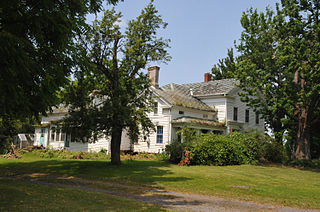
David and Mary Kinne Farmstead is a historic home and farm complex located at Ovid in Seneca County, New York. The complex consists of a Greek Revival style farmhouse and seven historic agricultural outbuildings. By family tradition, the house is believed to have been built about 1850 and is believed to have been used as a stop on the Underground Railroad. The outbuildings all date to the mid- to late-19th century and include an outhouse, machine shop, carriage house, horse barn, scale house, gambrel roof barn, and machine shed.

The McClelland Homestead is a historic farm in western Lawrence County, Pennsylvania, United States. Located along McClelland Road northeast of Bessemer, the farm complex includes buildings constructed in the middle of the 19th century. It has been designated a historic site because of its well-preserved architecture.
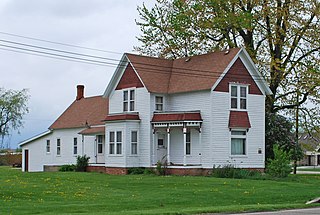
The John and Edna Truesdell Fischer Farmstead is a private farm, including house and outbuildings, located at 4896-5228 Sheldon Road in Canton Township, Michigan. The 1897 Queen Anne farmhouse located on the site is also known as the Michael and Catherine Hasselbach Fischer House. It was listed on the National Register of Historic Places in 2000.

The John and Eliza Barr Patterson House is a private house located at 6205 N. Ridge Road in Canton, Michigan, United States. It was listed on the National Register of Historic Places in 2000.
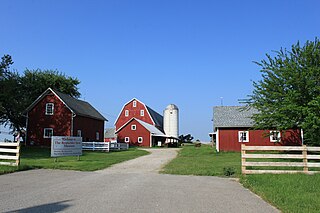
Rentschler Farm Museum is a historic site located at 1265 East Michigan Avenue near downtown Saline, Michigan. The site consists of an old-fashioned farmhouse and eleven outbuildings, including a hog house, an equipment shed, a hen house, and a windmill, among others. The site is now a museum that serves as a tourist attraction, showing how farming has changed over the years. The site was listed on the National Register of Historic Places in 2013.
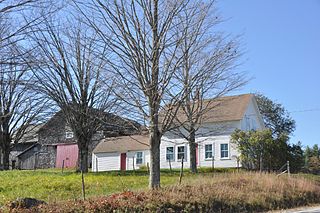
The Hersey Farms Historic District of Andover, New Hampshire, includes two farmsteads belonging to members of the Hersey family, located on the Franklin Highway in eastern Andover. The older of the two farms, the Guy Hersey Farm, was established c. 1850 by Hiram Fellows, and has been in the Hersey family since 1904. The adjacent James Hersey Farm was established in 1833 by Alfred Weare, and was acquired by Guy Hersey's son James in 1945. The two farms encompass 325 acres (132 ha), and were listed on the National Register of Historic Places in 2008.

The Donovan–Hussey Farms Historic District encompasses a pair of 19th-century farm properties in rural Houlton, Maine. Both farms, whose complexes stand roughy opposite each other on Ludlow Road northwest of the town center, were established in the mid-19th century, and substantially modernized in the early 20th century. As examples of the changing agricultural trends of Aroostook County, they were listed on the National Register of Historic Places in 2009.

The Paul Family Farm is a historic farmstead at 106 Depot Road in Eliot, Maine. Consisting of a well-preserved early-19th century Federal style farmhouse and a small collection of early-20th century outbuildings, it is a representative example of 19th-century farming in the area. The farmhouse parlor is further notable for the c. 1820s stencilwork on its walls. The property was listed on the National Register of Historic Places in 1998.

The Helvig–Olson Farm Historic District is an agricultural historic district located in rural Clinton County, Iowa, United States, 3 miles (4.8 km) southwest of the town of Grand Mound. It was listed on the National Register of Historic Places in 2000.

The Fox–Cook Farm is a historic farm property on Cook Drive in Wallingford, Vermont. Established in the 1790s, it is one of the oldest surviving farmsteads in the Otter Creek valley south of Wallingford village. It includes a c. 1800 Cape style farmhouse and a c. 1850 barn, among other outbuildings. The property was listed on the National Register of Historic Places in 1986.

Tyden Farm No. 6 Farmstead Historic District is an agricultural historic district located east of Dougherty, Iowa, United States. It was listed on the National Register of Historic Places in 2009.

Grouselands, also known more recently as the Waterman Farm, is a historic farm and country estate on McDowell Road in Danville, Vermont. The main house is a distinctive and rare example of Shingle style architecture in northern Vermont, and is the product of a major redesign of an Italianate farmhouse built in the 1860s. The house and immediate surrounding outbuildings were listed on the National Register of Historic Places in 1983.

The Axford-Coffin Farm, also known as Cranberry Lake Farm, is a farmstead located at 384-388 West Predmore Road in Oakland Charter Township, Michigan. It was listed on the National Register of Historic Places in 2002.

The Langford and Lydia McMichael Sutherland Farmstead is a farm located at 797 Textile Road in Pittsfield Charter Township, Michigan. It was listed on the National Register of Historic Places in 2006. It is now the Sutherland-Wilson Farm Historic Site.

The George Louk Farm is a rural farmstead located at 1885 Tooley Road near Howell, Michigan. It was listed on the National Register of Historic Places in 1995.
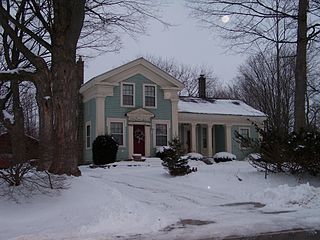
The Jacob Fishbeck Farmstead is a farm located at 5151 Crooked Lake Road in Genoa Township, Michigan. It was listed on the National Register of Historic Places in 2003.

The Timothy and Lucretia Jones Warner Homestead is a farmstead and archaeological site located at 4001 Pleasant Valley Road near Brighton, Michigan.

The James M. Jameson Farm is a farmstead located at 10220 North Parma Road near Springport, Michigan. It was listed on the National Register of Historic Places in 1980.

The Gordon Hitt Farmstead is a former farm located at 4561 North Lake Road near Clark Lake, Michigan. It was listed on the National Register of Historic Places in 1994. It now serves as a vacation rental.





























